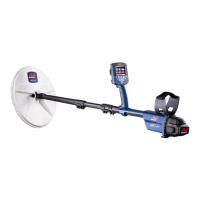Detecting Basics
34
the high degree of mineralisation and/or salt.
• In some mineralised soils a response may be received
from a concentration of orange/reddish dyke material
or clay. Remember, a metal target will get louder by
moving the coil even centimetres closer.
• If detecting areas of extremely variable mineralisation
detect along the ground contours rather than across
them. This will often stabilise the effect.
• In heavily mineralised areas the operator may need to
sweep the coil 10–20 mm (½”–1”) above the ground.
This should give a more stable Threshold and less
ground noise.
• Very sudden or large changes in the mineralisation of
an area may produce a signal from the detector. Usually
this signal is very broad and often only present in one
direction.
Simple Detecting Exercise
Before attempting to recover real targets, it is important to
understand how to interpret the audio and visual signals
of the detector.
1. Gather a collection of different metal objects, e.g.
various coins, gold and silver jewellery, a nail, pull-tab,
brass button and aluminum foil.
2. Take the detector outdoors, away from known
sources of electromagnetic interferences (EMI) and
metal objects.
3. Lay objects in a line, sufficiently spaced apart to allow
the coil to pass between them. Pay close attention to
the audio signals each different target produces.

